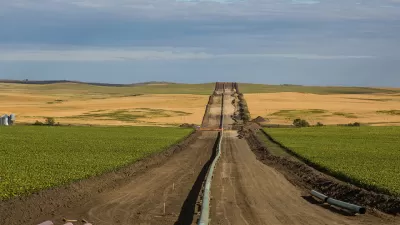With many oil pipelines stalled due to popular opposition and/or regulatory hurdles (e.g. Keystone XL and Northern Gateway, or even refineries opting for more flexibility) there seemed to be no end to the growth in moving oil by rail...until now.
Alison Sider writes that companies hoping to build rail terminals in Washington state capable of receiving the vast oil trains, also referred to as crude by rail or CBR, originating from the booming oil fields in the Bakken formation of North Dakota, are also encountering opposition.
The terminals are necessary to ship or barge the oil to refineries in Washington, Oregon, California and elsewhere, "(b)ut getting a permit in Washington is proving more challenging than companies expected." The "Lac Mégantic" effect is playing a role.
"The whole enterprise raises serious concerns about the heightened risk of transporting crude by rail," said Devorah Ancel, a staff attorney for the Sierra Club, an environmental advocacy group that has opposed some of the crude-by-rail projects at Washington ports.
There are economic advantages to building rail terminals in Washington state for receiving oil from North Dakota, now the second largest oil-producing state after Texas, producing over 1 million barrels a day (which includes neighboring states that compose the Williston Basin). It costs refiners only $10 barrel, "compared with $13 to $16 for a barrel of crude to travel by rail to California and $16 to ship a barrel to the East Coast," writes Sider.
But projects planned for some of the state's ports, where oil would be unloaded from trains, stored in tanks, and transferred to barges, have attracted criticism. A state hearing board recently overruled the City of Hoquiam, southwest of Seattle, which had issued permits to expand two terminals at the Port of Grays Harbor, west of Tacoma, to handle crude.
Pipeline projects that encountered opposition, in addition to Keystone XL, include the Northern Gateway in British Columbia, and the Freedom Pipeline from West Texas to California, which was dropped after California refineries opted to receive crude-by-rail.
However, the news is not all bad in the oil pipeline business. Keystone XL's southern leg, from Cushing, Okla., to the Gulf Coast at Port Arthur, Tex. will be operational on Jan. 3, reported the Huffington Post on Dec. 3.
FULL STORY: Moving Crude by Railcar Stalls on the Track

Pennsylvania Mall Conversion Bill Passes House
If passed, the bill would promote the adaptive reuse of defunct commercial buildings.

Coming Soon to Ohio: The Largest Agrivoltaic Farm in the US
The ambitious 6,000-acre project will combine an 800-watt solar farm with crop and livestock production.

World's Largest Wildlife Overpass In the Works in Los Angeles County
Caltrans will soon close half of the 101 Freeway in order to continue construction of the Wallis Annenberg Wildlife Crossing near Agoura Hills in Los Angeles County.

California Grid Runs on 100% Renewable Energy for Over 9 Hours
The state’s energy grid was entirely powered by clean energy for some portion of the day on 37 out of the last 45 days.

New Forecasting Tool Aims to Reduce Heat-Related Deaths
Two federal agencies launched a new, easy-to-use, color-coded heat warning system that combines meteorological and medical risk factors.

AI Traffic Management Comes to Dallas-Fort Worth
Several Texas cities are using an AI-powered platform called NoTraffic to help manage traffic signals to increase safety and improve traffic flow.
City of Costa Mesa
Licking County
Barrett Planning Group LLC
HUD's Office of Policy Development and Research
Mpact Transit + Community
HUD's Office of Policy Development and Research
Tufts University, Department of Urban and Environmental Policy & Planning
City of Universal City TX
ULI Northwest Arkansas
Urban Design for Planners 1: Software Tools
This six-course series explores essential urban design concepts using open source software and equips planners with the tools they need to participate fully in the urban design process.
Planning for Universal Design
Learn the tools for implementing Universal Design in planning regulations.
























